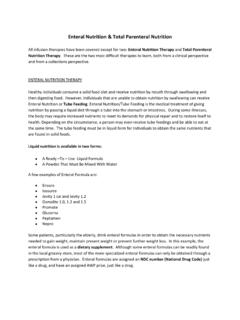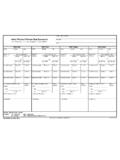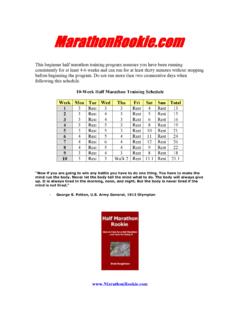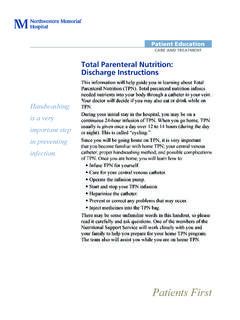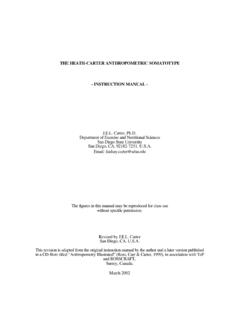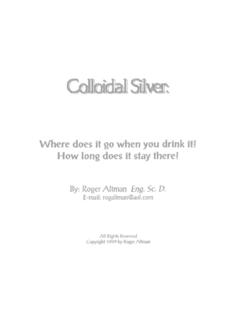Transcription of A TOTAL LOOK AT OIL BURNER NOZZLES - …
1 A TOTAL look ATOIL BURNER NOZZLESISO 9001 CERTIFIEDA Reference Guide for theBurner Service TechnicianThe complete oil heating system begins at the tank andends at the chimney. At the heart of the system is a tiny,yet important piece of hardware the nozzle . Itperforms the vital functions that keep the flamegenerating warm, comfortable heat. In fact, it playssuch a significant role in the entire system that we feelthe technician should know all about the this reference guide, we ll explore how the nozzleworks with other components of the system and giveyou some oil nozzle facts that can help you maintain aclean, reliable and economical heating Use NOZZLES ? .. 1 What the nozzle Does .. 2 How A nozzle Works .. 3 nozzle Selection; Delavan NOZZLES .. 4 nozzle Types .. 4 BURNER Manufacturers nozzle Recommendations; nozzle Interchange .. 6 Flow Rate; Proper Flow Rates.
2 7 Determination of Proper Firing Rate for a House .. 8 Spray Angle; Spray Pattern .. 9 BURNER Air Patterns; Recommended Combustion Chamber Dimensions .. 10 Effects of Excess Air on nozzle Performance; What Affects Droplet Size? .. 11 Effects of Pressure on nozzle Performance .. 12 Effects of Pressure on nozzle Flow Rate .. 13 Effects of Viscosity on nozzle Performance .. 14 Examples of Proper nozzle Selection.. 15 Fuel Saving Devices for the Consumer .. 18 Preheaters and Chemical Additives .. 18 Residential Oil BURNER Adjustments for Optimum Fuel Utilization .. 19 Good Filtration Is Important .. 19 Clean Air Technology; ProTek nozzle System .. 20 Delavan Filtration Products; nozzle Filters and Strainers; Line Filter .. 21 Other Accessories .. 22 nozzle Care and Service Tips .. 23 General Trouble Shooting Guide .. 26 Questions Asked by Oil Heating Service Technicians .. 30 Other Delavan NOZZLES Available.
3 331 NOTEThe information in this pamphlet is based onexperience and is to be used as a general guide modification to combustion units may createa fire hazard resulting in possible injury. Contact theoriginal equipment manufacturer before modifying thecombustion Use NOZZLES ?For a better understanding of how a nozzle fits into theperformance of an oil BURNER , let us first review the steps in theprocess of efficient all combustible matter, the oil must first be vaporized converted to a vapor or gas before combustion can takeplace. This is usually accomplished by the application oil vapor must be mixed with air in order to have oxygenpresent for temperature of this mixture must be increased above theignition continuous supply of air and fuel must be provided forcontinuous products of combustion must be removed from thecombustion simplest way to burn fuel oil is the old vaporizing pot typeburner in which heat is applied to a puddle of oil, thus vaporizingthe fuel.
4 These vapors are then burned after mixing with theproper amount of most applications, this method of vaporizing is too slow forhigh rates of combustion and cannot be controlled in the low rates,which leads back to the original question of why NOZZLES are of the functions of a nozzle is to atomize the fuel, or break itup into tiny droplets which can be vaporized in a much shorterperiod of time when exposed to high temperatures. This bookletwill be concerned primarily with the high-pressure atomizingnozzle since it is the most common in the Oil Heat the nozzle DoesThe atomizing nozzle performs threevital functions for an oil BURNER :1. AtomizingAs just discussed, itspeeds up the vaporization processby breaking up the oil into like 55-billionper gallon of oil at a pressure of 100-psi (standard in the industry). Theexposed surface of a gallon of oil isthereby expanded to approximately 690,000 square inches ofburning surface.
5 Individual droplet sizes range from .0002inch to .010 inch. The smaller droplets are necessary for fastquiet ignition and to establish a flame front close to theburner head. The larger droplets take longer to burn andhelp fill the combustion MeteringA nozzle is so designed and dimensioned that itwill deliver a fixed amount of atomized fuel to thecombustion approximately plus or minus5% of rated capacity. This means that functional dimensionsmust be controlled very closely. It also means that nozzlesmust be available in many flow rates to satisfy a wide rangeof industry needs. Under GPH, for example, over 20different flow rates and 6 different spray angles areconsidered PatterningA nozzle is also expected to deliver theatomized fuel to the combustion chamber in a uniform spraypattern and spray angle best suited to the requirements of aspecific BURNER .
6 More details on patterns and angles A nozzle WorksNow that we know what a nozzle is supposed to do, let s see howit does before we do, let s take a look at the cutaway showing thefunctional parts of a typical Delavan nozzle (Fig. 1). The flow rate,spray angle and pattern are directly related to the design of thetangential slots, swirl chamber and 1 Cutaway view of a Delavan , a source of energy is needed to break up the oil into smalldroplets. Therefore pressure is supplied to the nozzle , usuallyfrom a motor-driven pump at 100-150 psi (Fig. 2). But pressureenergy alone doesn t do the job. It must first be converted tovelocity energy and this is accomplished by directing thepressurized fuel through a set of slots which are cut in thedistributor at an angle, or tangentially, to create a high velocityrotation within the swirl chamber.
7 At this point, about half of thepressure energy is converted to velocity the oil swirls, centrifugal force is exerted against the sides of thechamber, driving the oil against the orifice walls, leaving a void orcore of air in the center. The oil then moves forward out of the orificein the form of a hollow tube. The tube becomes a cone shapedfilm of oil as it emerges from the orifice, ultimately stretching to apoint where it ruptures and throws off droplets of a nozzle WorksFIGURE 2 How a nozzle SelectionTo match a nozzle to a BURNER takes field-service experience, trial-and-error, or a good foundation of understanding angles, ratesand Ratings and TestingTo insure consistent quality, every Delavannozzle is tested for flow rate and spray angle onmodern, high instrumented test stands. Sprayquality is observed during testing foruniformity, balance and NozzlesTest oil is mixed to nominal no.
8 2 oilspecifications. The viscosity ismaintained within:1 .04 centistokes(.03 SSU), gravity to a TOTAL spread of11/2 APl and temperature at 80 F 2 F. Test pressure is set at 100 conditions are continuouslymonitored and instrument accuracy is maintained within .5% orbetter. nozzle testing is conducted in an air-conditioned, controlledenvironment, with a temperature variation of 4 F Types Type AHollow Cone (Creates stable flame at low flows)Figure 3 Hollow Cone nozzle (Type A)Hollow cone NOZZLES can be used in burners with a hollow airpattern and also for use in small burners (those firing GPHand under), regardless of air pattern. Hollow cone nozzlesgenerally have more stable spray angles and patterns underadverse conditions than solid cone NOZZLES of the same flow is an important advantage in fractional gallonage nozzleswhere high viscosity fuel may cause a reduction in spray angleand an increase in droplet A NOZZLES produce a spray which delivers fine dropletsoutside the periphery of the main spray cone.
9 These fine dropletsgreatly enhance ignition and create a stable flame for use withflame retention Type A Del-O-Flo low flow NOZZLES (see page 5).NozzleVialTypeColorARedDel-O-Flo ABlackBRoyal BlueDel-O-Flo BGoldWGreenType BSolid Cone(For larger burners & where air pattern is heavy in the center or for long fires)Figure 4 Solid Cone nozzle (Type B)Type B NOZZLES produce a spray which distributesdroplets fairly uniformly throughout the complete spray pattern becomes progressively more hollow at highflow rates, particularly above GPH. These NOZZLES may beused in larger burners (those firing above or GPH) toprovide smoother ignition. They can also be used where the airpattern of the BURNER is heavy in the center or where long fires Type B Del-O-Flo low flow NOZZLES see W(Can be used in place of A or B types in reducing specific problems)Figure 5 Type W NozzleType W NOZZLES produce a spray which is neithertruly hollow nor solid.
10 These NOZZLES frequently can beused in place of either solid or hollow cone NOZZLES between .40 GPH and GPH, regardless of the BURNER s air pattern. Thelower flow rates tend to be hollower. Higher flow rates tend to bemore Patent #4,360,156; Belgian Patent #889,019; Patent #2,076,696 Del-O-Flo NOZZLES are low-capacity nozzlesdesigned to minimize the usual Nozzleplugging problems associated with low flowrates. Del-O-Flo NOZZLES are available in Aand B performed a test in which a .50 gphDel-O-Flo nozzle and a .50 gph standardhollow cone nozzle were run continuously for23 hours from a double adapter using thesame oil supply. Engineers contaminatedclean oil with a controlled amount of ironoxide, rust and sand. The pictures to the leftshow the NOZZLES after the test (these views arelooking inside the nozzle body from the filterend).


